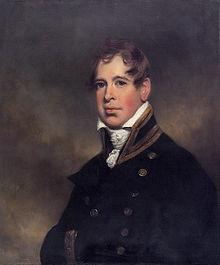William Beatty (surgeon)
| William Beatty | |
|---|---|

Portrait of William Beatty, circa 1806, by Arthur William Devis
|
|
| Born | April 1773 Derry, Ireland |
| Died | 25 March 1842 (aged 68–69) London, England |
| Buried at | Kensal Green Cemetery |
| Allegiance | United Kingdom |
| Service/branch | Royal Navy |
| Years of service | 1791–1839 |
| Rank | Physician of the Fleet |
| Battles/wars | Battle of Trafalgar |
Dr. Sir William Beatty FRS (April 1773–25 March 1842) was an Irish surgeon who served in the Royal Navy. Born in Derry, Ireland, he joined as a surgeon's mate in 1791 at the age of 18. He is best known as the Ship's Surgeon on the HMS Victory during the Battle of Trafalgar, at which he witnessed the death of Admiral Horatio Nelson, and for authoring an account of that battle – .
He was the eldest son of James Beatty, an officer in the Irish Revenue Service, and Ann Smyth. No records survive of his education, though he attended a local school, most likely Foyle College, before beginning his medical studies. He may have been apprenticed to his uncle George Smyth, a half-pay naval surgeon in nearby Buncrana, before studying at either the University of Glasgow or at the "The United Hospitals of the Borough" - the joint medical school of Guy's and St Thomas' Hospitals in London. What is known is that on 5 May 1791, the 18-year-old Beatty was examined before the London Company of Surgeons, and found qualified for employment by the Navy.
Beatty was promptly appointed Second surgeon's mate aboard the 64-gun third-rate ship Dictator, but was soon reassigned, moving to the 32-gun frigate Iphigenia in September 1791. He was promoted to First surgeon's mate of the 32-gun frigate Hermione on 1 February 1793, the same day that Revolutionary France declared war on Britain.
...
Wikipedia
